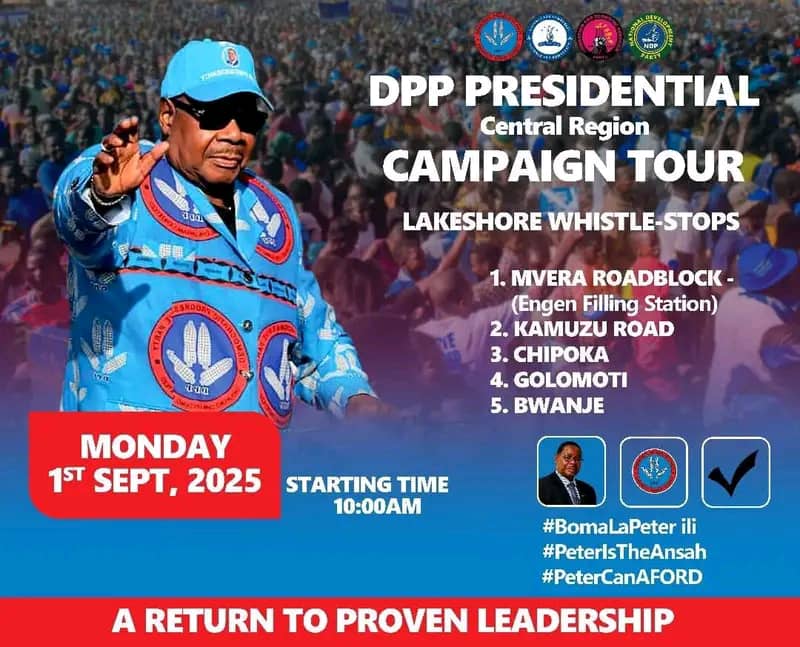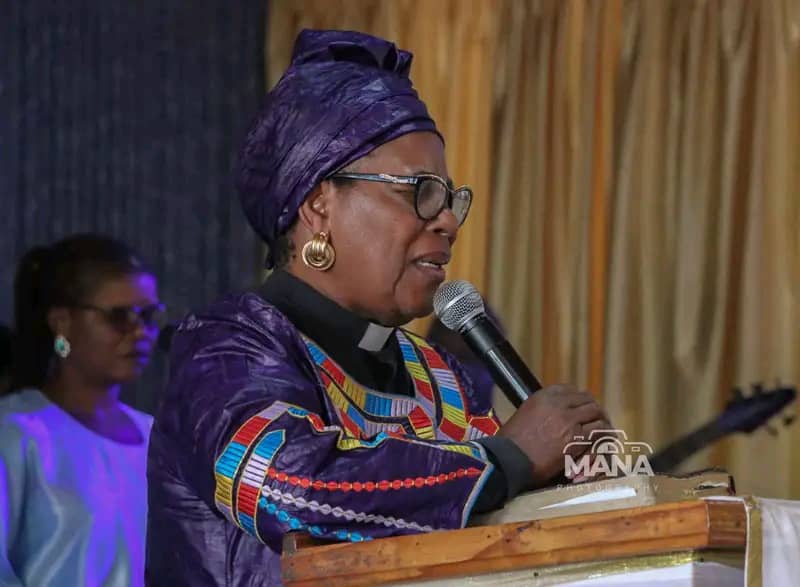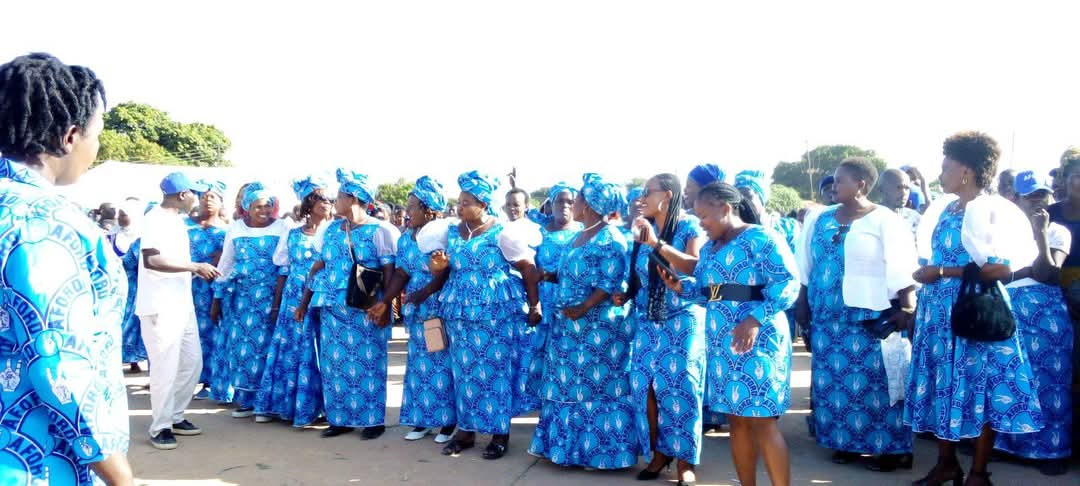By Burnett Munthali
On Monday, 1st September 2025, Professor Arthur Peter Mutharika, the presidential candidate of the Democratic Progressive Party (DPP), commenced a major campaign tour across several strategic constituencies in Malawi.
The tour is designed to engage directly with voters, reinforce his political messaging, and mobilize support ahead of the pivotal September 16 elections.
Mutharika’s first stop was Mvers, a constituency that has historically played a critical role in regional politics.
Mvers has been a swing constituency in previous elections, with voting patterns fluctuating between the DPP and other major parties depending on national sentiment and local development concerns.
During his visit, Mutharika engaged with local residents, listened to their concerns, and presented his vision for development, emphasizing infrastructure projects, economic opportunities, and improved access to social services.

The focus on grassroots engagement reflects a broader trend in Malawian electoral politics, where candidates recognize the importance of personal interaction to build trust and confidence among voters.
From Mvers, the campaign moved along Kamuzu Road, one of Lilongwe’s most critical transport arteries.
Kamuzu Road connects multiple communities, making it an ideal location to reach diverse voter groups within a short period.
By engaging constituents along this key route, Mutharika aimed to demonstrate accessibility and responsiveness to the concerns of urban residents who often feel disconnected from political leadership.
The third stop on the tour was Chipoka, a significant township with both commercial and rural interests.
Chipoka has historically been a contested area, with voters influenced by promises of development, infrastructure, and improved service delivery.
During his visit, Mutharika highlighted the DPP government’s achievements in economic management and outlined future plans for the region, including road upgrades, electrification projects, and enhanced market access for local farmers.
Golomoti, the next constituency on the tour, represents a more rural voter base, where community engagement and grassroots mobilization are critical to consolidating support.
Rural constituencies like Golomoti have often been decisive in Malawian elections, as their voting patterns can tip the balance in closely contested regions.
In Golomoti, Mutharika emphasized agricultural support programs, affordable fertilizer schemes, and initiatives to enhance productivity and food security.
The final stop of the day was Bwanje, a constituency noted for its dynamic electorate and strategic importance in the broader political landscape.
Bwanje has historically been considered a bellwether constituency, with election outcomes often reflecting broader national trends.
Here, Mutharika engaged with community leaders, local business owners, and residents, stressing the DPP’s commitment to sustainable development, education, healthcare, and job creation.
The structure of the campaign tour illustrates a deliberate strategy: cover both urban and rural constituencies in a single day to maximize outreach, consolidate support, and showcase a hands-on leadership approach.
In Malawi, such roadshows have long been a staple of electoral strategy. Previous campaigns by leaders such as Bingu wa Mutharika, Joyce Banda, and Lazarus Chakwera have demonstrated the effectiveness of personal engagement in boosting voter confidence and translating popularity into votes.
For example, in the 2014 elections, Bingu wa Mutharika’s extensive roadshow campaign in rural areas was credited with solidifying support among communities that previously felt neglected, contributing significantly to the DPP’s electoral success.
Similarly, Lazarus Chakwera’s 2019 campaign employed a mix of urban rallies and rural constituency tours, which helped him build a nationwide coalition and ultimately secure the presidency.
The historical significance of the constituencies visited during Mutharika’s September 1 tour cannot be overstated.
Mvers and Kamuzu Road serve as urban hubs with high voter density, where the electorate is often responsive to policy discussions and tangible development promises.
Chipoka and Golomoti, meanwhile, represent semi-urban and rural areas where voters prioritize service delivery, agricultural support, and basic infrastructure improvements.
Bwanje, being a bellwether constituency, carries symbolic weight, as its voting patterns can reflect national sentiment and momentum heading into election day.
Political analysts have noted that the combination of urban visibility and rural outreach is critical in a country like Malawi, where regional voting trends can vary widely.
For instance, the central region has traditionally leaned toward the Malawi Congress Party (MCP), while the southern region has been a stronghold for the DPP, making targeted campaigning essential for any candidate seeking to broaden appeal.
Moreover, voter behavior in constituencies like Chipoka and Golomoti has often been influenced by local development projects and the perceived effectiveness of previous administrations.
By highlighting infrastructure investments, electrification schemes, and market support programs, Mutharika seeks to reinforce the DPP’s record while promising continued development.
Engagement during the campaign also involves interactive sessions where residents can ask questions, voice grievances, and provide feedback, ensuring that the candidate addresses local priorities directly.
This approach resonates with Malawian voters, who often value leaders that demonstrate both accessibility and a willingness to respond to community concerns.
Mutharika’s strategy also reflects the increasing role of media and social media in shaping public perception.
Coverage of roadshow activities, including photos, videos, and interviews, amplifies the campaign’s reach beyond those physically present, creating broader visibility and engagement.
In previous elections, candidates who successfully leveraged both in-person engagement and media amplification often saw higher voter turnout and stronger support, particularly among younger and urban demographics.
Attendance and enthusiasm at rallies are also used as proxies for popularity, giving the campaign team insight into the effectiveness of messaging and the resonance of development promises.
Observers note that these tours can create a sense of momentum, reinforcing voter perception that a candidate is proactive, responsive, and committed to addressing the nation’s challenges.
However, the campaign must also contend with competition from opposition parties, which may employ similar roadshow strategies, media engagement, and grassroots mobilization to sway voters.
Historical trends indicate that early engagement in key constituencies can provide a strategic advantage, as it allows candidates to set the narrative and build relationships before opposition campaigns intensify.
Analysts also point out that the diversity of constituencies visited ensures coverage across different socio-economic profiles, enhancing the campaign’s ability to tailor messages to specific voter concerns.
In addition, showcasing the candidate’s presence in both rural and urban areas signals inclusivity and a commitment to all citizens, rather than focusing solely on traditional strongholds.
The campaign tour on 1st September 2025 demonstrates the DPP’s tactical emphasis on visibility, direct voter contact, and strategic messaging, essential elements for success in Malawi’s competitive electoral environment.
Concluding Analysis
Professor Arthur Peter Mutharika’s campaign roadshow underscores the enduring importance of direct voter engagement in Malawian politics.
By strategically covering constituencies such as Mvers, Kamuzu Road, Chipoka, Golomoti, and Bwanje, Mutharika balances urban outreach with rural engagement, ensuring broad coverage and visibility.
The historical significance of these areas, combined with past voting trends, highlights the critical role of targeted campaigning in securing electoral success.
Comparative examples from previous election cycles demonstrate that personalized interaction, media amplification, and community responsiveness are decisive factors in translating popularity into votes.
As Malawi approaches the September 16 elections, the effectiveness of this tour will depend on the candidate’s ability to address local concerns, communicate a coherent development vision, and energize supporters across diverse regions.
Mutharika’s strategic approach exemplifies the complex interplay between constituency outreach, historical voting patterns, and national political momentum in shaping the outcome of elections.



